Heliciculture is one of the branches of animal husbandry that deals with raising edible land snails, primarily for human consumption. Due to the limited biological and zootechnical knowledge of the mollusk, heliciculture managed to establish itself on the market in the last 50 years.
Heliciculture began predominantly in France and Italy, with the French being the first to start studying snails in laboratories and becoming some of the largest consumers of snail meat now.
Nowadays, heliciculture is an agricultural activity that is progressively widespread and practiced. Moreover, some saw the opportunity and turned heliciculture into a successful business.
Since snails are less picky about fodder and require less space, time, and expense, a mini snail farm can become a truly profitable business. And if you’ve decided to get involved in such an adventure, here are some useful tips that you can implement by launching such an activity.
Contents
Why do snail farm?
First of all, a snail farm involves a small investment estimated by the specialist at about $ 10,000, and there is no need to buy special equipment or agricultural machinery. In addition, a snail farm is easy to manage because the snails are not pretentious, do not get sick, and take care of themselves. It can therefore be said that they grow up almost alone, without requiring a continuous presence on the farm.
Another thing is that there is a big market for this type of meat, which allows you to recover in a short time from the investment made. There is a vast demand for farmed snail meat, which is why it has been listed on the stock exchange.
How do you start a snail farm?
To start a snail farm, it is necessary to procure quality baby snails whose meat is in demand on the market. Currently, the most appreciated snail meat among consumers is that of Burgundy snails. The most popular Burgundy snails used for breeding, and the ones that you should acquire, are Helix Pomatia, Helix Aspersa Maxima, and gray Helix Aspersa Muller.
Another thing that needs to be considered and that influences the business is the climate conditions where the farm is located. A snail can live for about 8-9 years and can produce up to 60 eggs outside the hibernation period. The business becomes profitable if the minimum number of snails is 500.
In Africa, on the other hand, they also use giant snails called Achatina Fulica (Lissachatina Fulica). They are sliced and prepared in cans, being sold in some markets as Escargot.
Which are the best species of snails for farming?
Helix Pomatia (The Roman snail, Burgundy snail, Edible snail, or escargot)
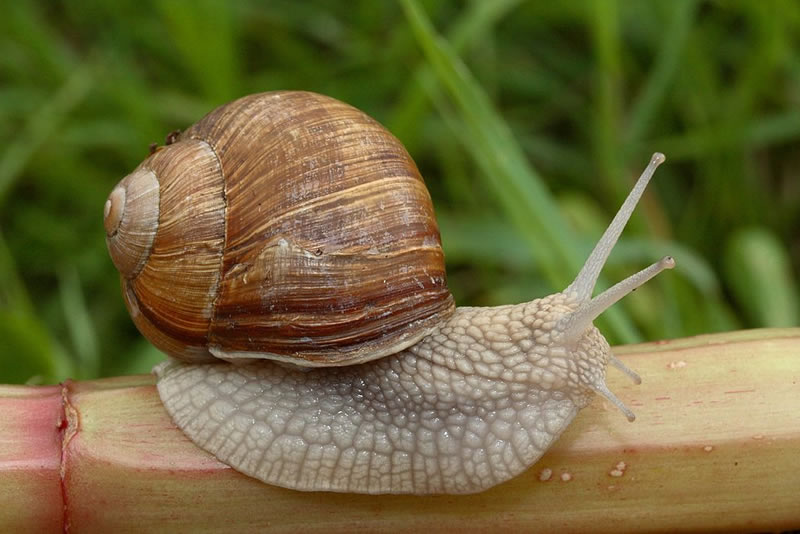
Found both in Europe and USA, Helix Pomatia can reach a 1.18 – 1.96 in (30-50 mm) shell and a 1.18 – 1.77 in (30-45 mm) height. This snail species boasts the title of one of Europe’s biggest species of land snail while being extremely popular and appreciated by gourmets and chefs.
Helix Aspersa Maxima
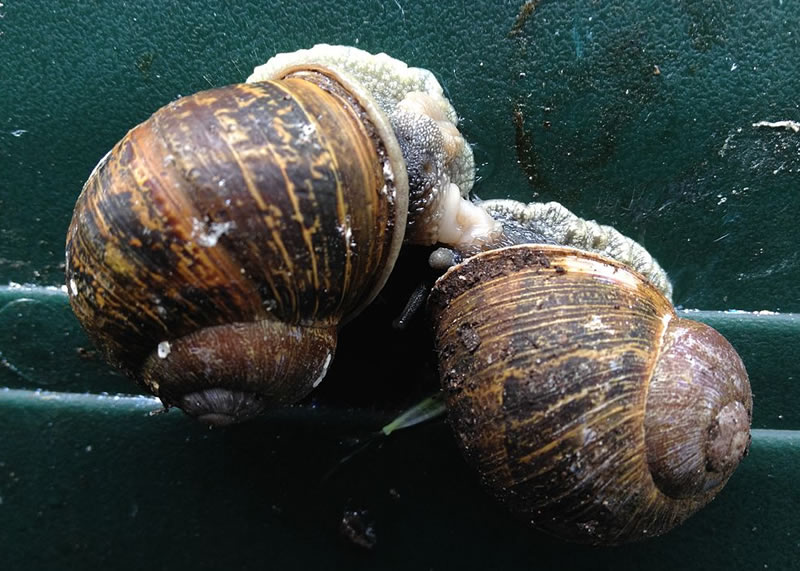
Also known as Gros Gris, Helix Aspersa Maxima are gray snails preferred in the cooking world due to their great meat. This snail reaches its maturity in 5-7 months and ends up weighing 16 to 0.88 oz (25 g).
Helix Aspersa Muller
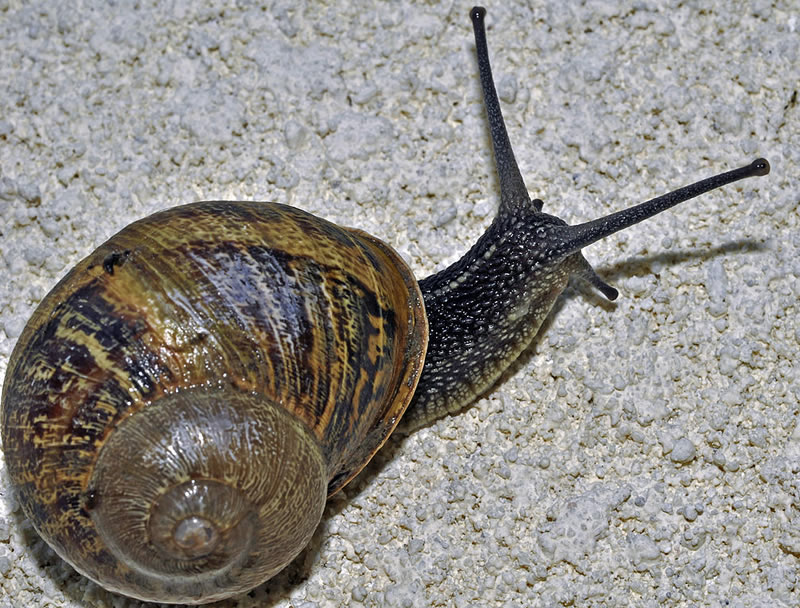
Helix Aspersa Muller or Petit Gris is highly popular for the delicate flavor of its meat. This snail species can lay between 80 to 120 eggs and weighs 8-10 grams at full maturity.
Achatina Fulica
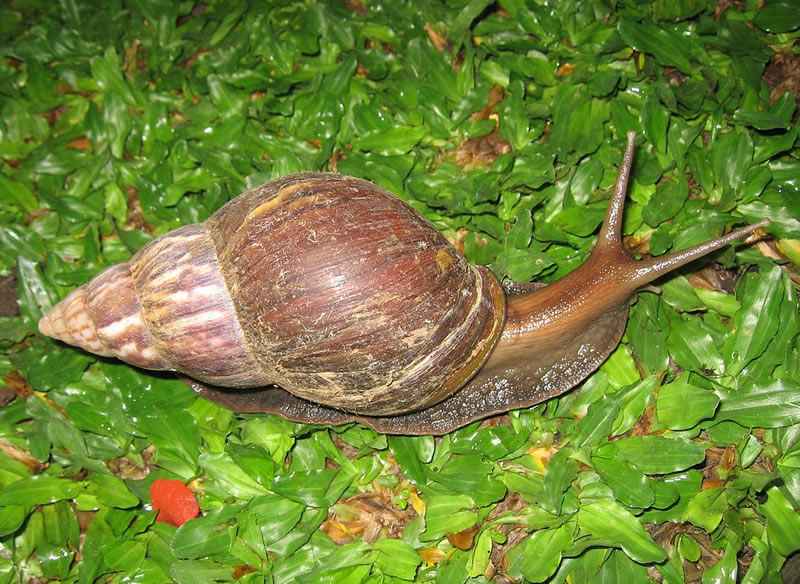
Sharing the name of Giant African Snail with the previous species from this top, the Achatina Fulica can reach 1.13 oz (32 g) in weight and lay 100-400 eggs after a single mating. The period of growth to adulthood takes up to 6 months.
Achatina Achatina
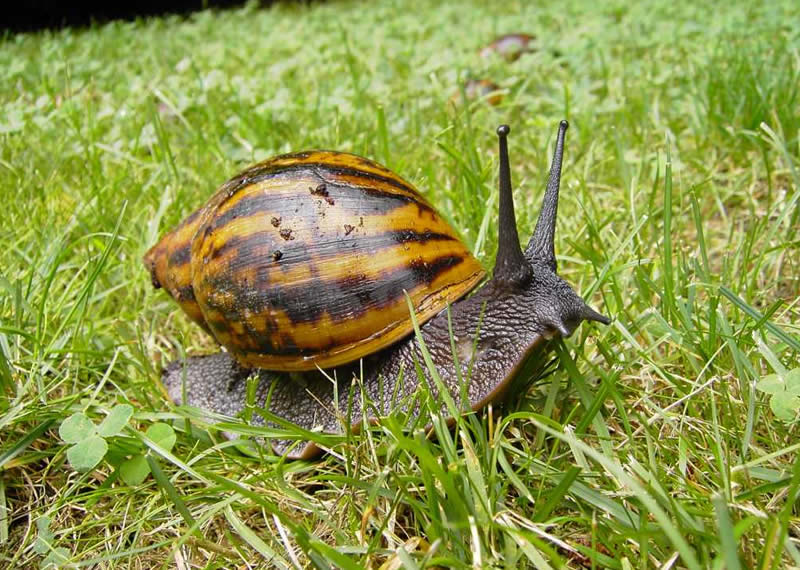
The Achatina achatina also known as the giant African snail is one of the biggest snails on earth. This snail can lay eggs every 2-3 months and can reach can grow to a length of 7.1 in (18 cm) with a diameter of 3.5 in (9 cm).
Archachatina Marginata
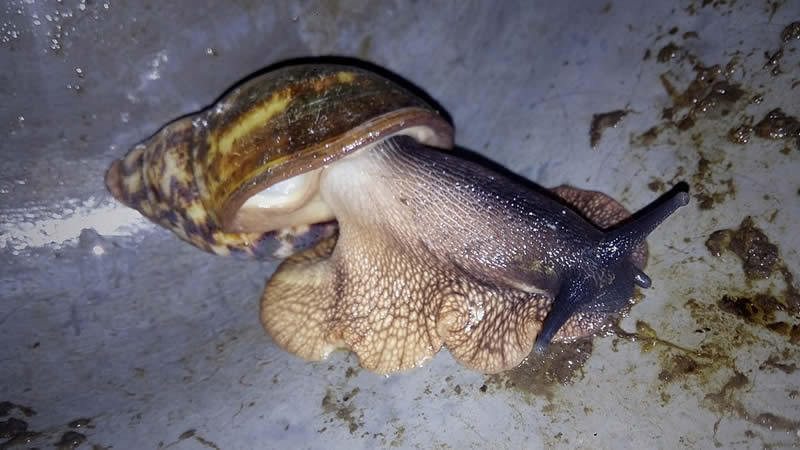
Archachatina marginata or Banana rasp snail reaches maturity in 20-22 months. Its shell can grow up to 8.26 in (21 cm) in height and 5.11 in (13 cm) in diameter. As for its ability to reproduce, the Archachatina marginata can lay 40 eggs with a short incubation period of 40 days.
Farm breeding of snails & snail breeding conditions
For a successful snail business, you need the right equipment that should contain the following:
- snail cages
- humidity measuring instruments (hygrometer)
- temperature measuring instruments (thermometer)
- soil moisture measuring instruments
- light measuring instruments
- a scale of weights
- tool for determining the size of snails
- a set of finding the soil component
- a magnifying glass for observing eggs
- climate control equipment (temperature + humidity)
- water regulation equipment (a sprinkler system for permanent humidity and a drain system)
In addition, light and shade will be provided, and the surface will be protected from pests. Some experts claim that the best results could be obtained when using snails of the same type and from the same generation. It is also recommended that new babies be placed in separate spaces.
In terms of systems, there are four possibilities for snail farms:
- placed outdoors
- placed in air-conditioned buildings
- placed in airtight tunnel or plastic house systems
- placed in ecological houses
In general, snails breed and are born without problems in a strictly controlled environment, and at 6-8 weeks, they can be placed in outdoor spaces to mature faster.
The climate: A favorable climate (59 – 75 F) with high humidity (75 – 95%) is the best condition for snail farms. The optimum temperature for most species is 70 F. When the temperature drops below 45 F, the snail retreats into hibernation. Beyond 54 F the snail becomes inactive, while below 50 F the whole growth process is stopped. When the temperature exceeds 80 F or if it is a very dry period, the snails hibernate. The wind is not their best friend because it accelerates water loss, and they must retain moisture.
Humidity: Snails need a moist, but the not wet, environment. Although they need high humidity (75-95%), the soil on which they are placed should not be wet. In case of heavy rain, the water must be drained from the area to minimize the risk of drowning. A soil moisture content of 80% is very suitable. If necessary, mist sprays can be used, such as those used to grow plants in dry areas to maintain the right moisture levels. Snails tend to hide in shelters most of the day and become active during the night, in the dark and cold. The low temperature stimulates the activity and the night dew helps the snail to move.
The soil: The ideal soil for snails is the one that contains between 20 and 40% organic matter, which is the same soil used for green and leafy garden plants. This type of soil is perfect because it does not contain too much sand or clay. Snails cannot crawl into hard, dry clay, while sandy soils do not have the required water content.
The acidity and the calcium level in the soil must be carefully monitored because the snail shell contains 97-98% calcium carbonate. If the soil is too acidic, it can be neutralized with a lemon (lowering the pH to 7), while a little lime can be added for the calcium concentration. A researcher treats the soil with 12.5 cm3 polyacrylic amide at 160 g M. M. / preparation at 250 cm3 of water per 1 kg of dry soil. This stabilizing treatment helps the structure of the soil to withstand washing, allowing regular cleaning without affecting the fine structure of the soil so necessary in laying eggs.
Snails usually dig into the soil, and after consuming food, they can also eat the dust. Sometimes they consume either food or dust. Therefore, good soil will favor snails’ growth even if they already benefit from a balanced diet. This may be a reason why snails should not be raised in a small space. If the soil is not changed regularly, it will be filled with mucus and leaks, and chemical changes may occur in its composition. Good soil is a mixture of peat, clay, compost, and CaCO3, at a pH level of 7.
How to make a snail house
The surfaces on which the snails are grown must ensure the caregiver’s movement and access without stepping on the snails. Therefore, the surface should have a wider length and a smaller width. The area can be a channel made of wood, stones, pieces of fiber cement, or galvanized steel. Fences made of galvanized metal or thick plastic parts prevent some predators. It is also recommended that the entire surface be covered with a screen or net to protect the snails from birds or other pests. A roof is also a good idea because it protects against rain. The shade (which can be made from a thin screen) for warm winter days, ensures the latent state of the snails. 5 mm or thinner mesh is used for thin screens or fences. A thicker net will be used for those surfaces that house the babies.
Snails love hiding places, especially during hot days. To provide them with these hiding places, you can buy plastic pipes for drainage in the ground. These pipes must be cut lengthwise and then placed one up, and one down, so that a kind of shelter will be created.
A sprinkler system will provide moisture when needed. You have to keep in mind that this system should only work during the day because if you start early in the morning, the snails will come to the surface and will be exposed to the sun. At the same time, the temperature and humidity must be monitored with a thermometer and a hygrometer.
Prevention of escape from the site: The first technique for preventing escape is to bend the top of the fence as in a semicircle. Because there is a risk that Helix Aspersa can escape even with this technique, an electric fence can be used too. The net above can be made of at least 2 wires placed at a distance of 2 – 4 mm between them, each being crossed in the opposite direction by the electric current. Connect a battery or transformer between 4 and 12 volts to each wire. The snail will be lightly pinched and will withdraw from one wire to another.
A second technique for preventing the escape of snails consists in making the cover fence in the shape of the letter V, obtaining a sharp angle of 20 °. The snail shell will hit the bend before it reaches the top, lock, and the angled screen will automatically compensate for the size of the snail.
The last alternative that would prevent escape and is suitable for hard-walled, sturdy fencing is to place a horizontal screen on the walls that project the snail inward within a few inches of the wall. As it moves, the snail swings on a string from which it falls because it is not large enough to allow it to advance.
Garden area: You can also create a square perimeter containing a garden of 10 square meters. In this garden, you can plant several types of plants such as nettle or artichoke. Thus, snails will be able to choose their food. In this type of arrangement, the sprinkler system will be turned on only in the evening and only during periods without rain. A disadvantage of the method is that if the snails have not reached maturity at the end of the year, it is difficult to plant the next crop in the garden.
Closed surface: Snails raised indoors under controlled conditions will multiply according to the geographical origin of the breeding stock used. Thus, it has been observed that some individuals of Helix aspersa from England grow better indoors. The multiplication of snails in such conditions is achieved by maintaining the temperature at 70 F and the humidity between 80 and 90%, some sources even claiming 95%. In some places, 75% humidity is recommended during the day and 95% during the night. The Heliciculture Center indicated at one point that a humidity of 65 – 75% during the day and 85 – 95% at night is necessary for a temperature of 68 F. In any case, however, a higher humidity of 95% should be avoided even for a short amount of time, because it can kill snails.
The optimum temperature and humidity hinge upon several factors such as snail species and background. Different snail species react differently to the time of day. The rate of illumination until dark influences the activity, feeding, mating, and even egg-laying. It appears that 18 hours of light stimulates the development of Helix aspersa, while less than 12 hours inhibits the process. 18 hours of light is optimal for reproduction, although this function is performed during darkness.
Breeding boxes and cages: Snails can also reproduce in boxes or cages arranged one above the other with a hole for water and another for food. In this environment, an automated sprinkler system will be used to maintain humidity. The plastic trays used should not be deep as it increases the chances of the snails drowning in them. Small plastic bowls (such as 3-inch flower bowls) will be filled with sterilized powder or pH-neutral clay soil and will be placed on gravel to make room for laying eggs. Each bowl will be removed and replaced after the snails lay their eggs. These bowls can be placed concentrically so that the gravel does not have to be changed when changing or excluding a single box.
After the snails have laid eggs, the bowls will be moved to the incubator to develop. The baby snails that have just hatched will be kept here for 6 weeks. Then they will be moved to a separate area because the development is more pronounced if the snails of the same size are in the same group. An 8-hour lighting interval is optimal for babies.
Mixed systems: Snails can be left to lay their eggs in an open space, after which they will be moved to boxes, following the same algorithm. You should look for snails on the site that have already dug holes to lay their eggs. They can be identified by the part of the shell that is not yet buried. The place where the eggs are laid will be marked with a sign placed in the vicinity. After the snail has fulfilled this role and leaves the area, a hand trowel will be used to find the eggs and move them. This stage is difficult because the eggs can be destroyed or covered in dust.
Example: Five stages in snail growth
Some breeders distinguish five stages in snail growth: reproduction, hatching, youth, fattening, and maturation (final fattening). In a simple example, the box is made of concrete walls, with curved areas for shelter, special spaces for food, rich soil in worms that will clean the soil on the sides, and vegetation.
Mosquito nets or screens will be the roof. These boxes can be placed outside or kept indoors where the temperature does not fluctuate between extremes (too hot or too cold). Some researchers say that a snail raised in open space conditions lays an average of 7 to 12 chicks. But if the weather conditions are favorable, a snail can give birth to up to 15 babies.
Snail breeding
Snails are hermaphrodites, having both female and male reproductive organs, but can only mate with individuals of the same species to lay eggs.
In order to mate, the snail must first reach a certain maturity and a certain size. This development generally takes several years. When these two factors are reached, some snails can function as males for a season and then become females. Others perform both roles at once, fertilizing each other simultaneously. Their mating season is in late spring, but sometimes a second mating takes place in the summer.
In some tropical areas, snails mate several times a year, while in some climatic zones, snails mate in October.
A few weeks after mating, a snail will begin to lay eggs, but the snail can store the collected sperm for a year. Snails lose a lot of weight when they lay eggs, some of which do not recover. About 1/3 of the snails will die after the season they lay their eggs. Moreover, snails may refuse to mate with individuals of the same species if they come from an area other than the one they live in (an individual of Helix aspersa from the south of France may refuse an individual of Helix aspersa from the north of the country).
Another thing to be prepared for the mating season is the soil on which the snails will lay their eggs. Both dry and clay soils are not suitable for building a nest because snails will either fail to hide their eggs, or the larvae will encounter difficulties when they emerge from the nest in these types of soils. The soil must be protected from ants, weevils, and other living things. The perfect soil for snail eggs is that which contains between 20 and 40% organic matter. Also, the clay should be maintained at a temperature between 65 F and 80 F, preferably 70 F, and soil moisture of 80%. A researcher will immediately take the eggs after they have been laid, count them, and keep them on the wet cotton until the egg opens and the little creature comes to feed.
The snail will begin laying eggs in July or August, after 2 to 8 weeks of mating. The snail will make holes in the ground, where it will stick its head or enter with almost the whole body, after which it will lay eggs through the genital orifice, which is in the back of the head.
After that, the snail will lay in 1-2 days between 30-50 eggs, after which it will cover the hole in the earth with a mixture of mucus and dust. This mucus is actually produced by the snail when it crawls into the ground, allowing it to retain moisture inside its soft body.
Helix pomatia eggs measure 3 mm in diameter and have a calcareous shell with a yolk content. Helix pomatia chicken hatches from the egg 3-4 weeks after laying. This period is influenced by the temperature and humidity of the environment. These snails feed and grow until the weather cools, then they make deep holes and isolate themselves in their own shell to hibernate in the winter. When the earth warms in the spring, the snail emerges from the ground and seeks to recover moisture from its body and feed.
On the other hand, Helix Aspersa eggs are laid 5 to 15 days after mating and have a diameter of 3 mm, a white color, and a spherical shape. However, these data are influenced by climate and various variations that can change snail habitat. For example, Helix aspersa can lay eggs every month from February to October if the climate is warm and humid. Pairing and laying of eggs occur when at least 8 hours of light in a day are interrupted when the day shortens. If it is warm enough, the chicks hatch in about 2 weeks, but this period can increase up to 4 weeks if the weather is colder.
It is the climate that influences the emergence of the baby snail. In a warm California-like climate, the Helix aspersa snail reaches maturity around two years of age, whereas in a South African climate, snails can reach the age of maturation at 10 months of life. However, in general, breeding activity in Helix Aspersa takes place in their second year of life. Baby snails that appear at the beginning of the season reach adult size if fed properly, within a year.
Like Helix Pomatia, Helix Aspersa eggs are laid in the ground or on the surface of rugged soil in organic matter. Baby Helix Aspersa measures about 4 mm in length when they come out of the egg and grow about 10 mm in a month, reaching 35 mm in length during the first 6 months and being even sexually mature. Reaching sexual maturity lasts between 6 and 16 months, depending on the weather and the availability of calcium. This type of snail lives 5-6 years, reaching in some cases even up to 9 years.
Cannibalism in the post-egg-laying period
The first snail to emerge from the shell will eat its shell, thus ensuring the calcium level needed. Then, they can even eat the other eggs that didn’t hatch yet.
To lower the rate of cannibalism, eggs should be kept at an optimal temperature of 68 F. This controlled temperature will make them hatch at a distance of 1-3 days between them, reducing the rate of cannibalism.
Some of the eggs that will be, in the end, eaten are not fertile or have not developed properly, although there are situations in which mature embryos are devoured. A high density of eggs increases the rate of cannibalism, due to the proximity between them.
Snail egg contains a high level of protein that helps baby snails grow fast and healthy. Thus, the snail egg is the ideal food for snails that will eat only eggs of the same species.
Snails feeding
What is important about the snail feeding process is that the food and water storage areas must be cleaned regularly. Food should not be put in one place because snails will not have access to it, and water should be placed in a flat bowl to eliminate the risk of snail drowning.
The amount of food consumed by snails is influenced by temperature, light intensity, air humidity, access to water, and preferably food compared to administered food. Snails may not eat every day, but within 24 hours, they can consume an amount of food equivalent to 10 – 20% of their body weight. Evening irrigation is recommended during dry periods, as it will encourage feeding due to ease of movement to the food area.
Snails of certain species collected from different regions have different feeding habits. Among the foods eaten by snails are Alyssum, apple fruit and leaves, apricots, artichokes, bull’s eye, barley, beans, California cranberries, any variety of cabbage, chamomile, carnation, cauliflower, beets, celery, ripe cherries, lemons, clover, cucumber (snail favorite), wolfberry, dandelion, hibiscus, mallow, calla, leek, lettuce, lily, magnolia, mulberry, ladybug, nettle, currant, oak, green onion, pansies, peach, ripe pears, peas, petunias, plums, potatoes (raw or cooked), pumpkin, radishes, rapeseed, roses, sorrel, spinach, sweet peas, thistle, tomatoes, kale, wheat, tavern. Snails avoid consuming plants that produce defensive chemicals or those with defensive stems.
Snails can also be fed with dry or moist bran aside from green leaves. Their diet can contain 20% wheat bran and 80% fruits and greens.
Calcium is an important nutrient in the diet of snails, helping them to stay healthy. Therefore, some breeders use oats, cereals, soy, or porridge to provide the necessary calcium, while others prefer to administer calcium once a week if the soil does not contain it. Calcium can be mixed with wet bran or mashed potatoes, so it will not seep into the soil unless consumed immediately. However, if you feed snails with vegetable waste, broken fruit, or baked potatoes, you should remove the excess food because it gets damaged.
The soil where the snails live must not contain salts or alkaline substances that could burn the snails.
Two preferred snail foods that ensure healthy growth are boiled porridge containing 58% wheat, 16% soybeans, 18% sorghum, 7% limestone flour (40% calcium), and pellets for chickens containing 5% concentrate, 10% wheat, 15% soy, 20% sorghum, 44% barley, 6% limestone flour (40% calcium). Pellets are suitable for mature snails, while porridge is good for babies. Pellets should be crushed if administered to snails. Snails prefer moist food. If you feed them dry porridge, then access to water sources should be facilitated.
Pests and diseases
Maintaining daily hygiene can help prevent snail disease. Therefore, food must be charged and discharged daily to avoid damage.
If the population is very dense, you need to watch out for parasites, fungi, and microarthropods because they can spread quickly and attack snails. Also, in a crowded environment, bacteria such as Pseudomonas aeruginosa cause intestinal infections that can be transmitted quickly.
The snail farm must be protected from pests such as mice, rats, moles, skunks, weasels, birds, frogs, toads, insects (varieties of beetles and crickets), and fly species, even some cannibal snail species (Austrorhytida capillacea).
FAQ – Snail facts & information
Is snail farming profitable in 2022/2023?
Unlike other livestock businesses, snail farming is low-risk and profitable.
One of the indications that such a business would be successful is that the world demand for snails is still growing, as people are constantly searching for new ways to grow nutritious and high-protein food in a smaller space. Still, the product’s availability directly from nature is declining, because the process of collecting snails in nature is an activity specific to countries with a poor economy such as those in Eastern Europe, the Middle East, and the Mediterranean Mediterranean countries. Due to the rapidly changing economic and political conditions, trade and sanitation embargoes, and rotating, limited agriculture, the availability of snails in these countries became more and more limited.
In terms of cost and time, you can start the snail farming business by applying the so-called Italian method. The Italian method involves growth in the complete biological cycle, from birth to final fattening in the wild, on open land with almost full use of plant foods.
On the other hand, raising snails in a closed environment such as a greenhouse or barn while using constant feed based on concentrated flours is more expensive and difficult to manage.
Finally, snail farming is definitely a profitable business worth trying in 2022/2023 due to its ease, low risk, and fairly high market demand.
How long does it take for a snail to grow to full size?
Snails can grow to full size in 9 to 12 months. However, this period, in which snails tend to be fully grown, is strongly influenced by the type of snails, environmental conditions, and calcium-rich food. Once snails are fully grown and have reached consumption maturity, depending on the size and individual development, they should be divided into two categories: the big ones should be kept for breeding, while the others can be traded. Once snails are fully grown and have reached consumption maturity, depending on the size and individual development, they should be divided into two categories: the big ones should be kept for breeding, while the others can be traded.
Which country eats most snails?
The largest snail-consuming country in the world is France, where approximately 30,000 tons of snails are consumed annually. France is followed by Italy. These two countries have an annual consumption of 300 million euros and an import of between 60% and 80%.
Is eating snails good?
Snail meat is very healthy, which is why it has become more and more consumed nowadays in countries such as Italy, France, and the Iberian Peninsula, where it is considered a real delight. Snail meat is low in fat, salty, with an intense flavor, and very nutritious, providing a high intake of protein (14-16%) and iron (45-50 mg/kg) while the caloric value is low (60- 80 kcal / 100g).
In addition, the amino acids found in snail proteins and their saliva contribute to the reconstitution of gastric tissue, leading to ulcer healing. They also help cure lung and throat problems because they lubricate the airways. Last but not least, the amino acids in snail proteins play a significant role in promoting the elimination of cellulite and varicose veins.
Snails: What are the health benefits of snail meat?
The consumption of snails is considered beneficial for human health because it is low in fat but with high protein content while containing selenium, magnesium, and other vitamins and minerals.
Here are just some of the potential health benefits of eating snails:
- an excellent source of lectin, which has anti-cancer properties and stimulates the immune system
- a great source of iron, which improves anemia caused by iron deficiency
- an important source of oligosaccharides, which treat acne and hydrate the skin
- selenium from snail meat can protect against heart disease while improving your immune system and thyroid health
- vitamins such as A, E, B1, B3, B6, and B12 from this meat improve brain function and minimize inflammation
- the mucus rich in allantoin, collagen, and elastin helps to treat skin diseases, bone fractures, and smooth scars
- the snail meat has the potential to lower the risk of high blood pressure due to Omega 3 fatty acids
What are the nutritional content, vitamins, and minerals of snails?
Snails are a great source of lean protein because they are virtually fat-free, carbohydrate-free, and sugar-free. They contain a lot of iron, magnesium, selenium, phosphorus, and potassium.
The nutrient composition of raw snails (per 100 g of edible portion):
Energy: 80.5 kcal (337 kJ)
Moisture: 79 g
Protein: 16 g
Available carbohydrates: 2 g
Dietary fiber: 0 g
Fat: 1 g
Magnesium: 250 mg
Calcium: 170 mg
Iron: 3.5 mg


I am blessed with the content, thanks for enriching my life with the write up.
It is our pleasure.
Great website
Thank you BENJAMIN!
Very enriching information that transcends every aspect of this culture as
Thanks.It is very practical and knowledgeable.
That was a fascinating read, I am working on a project to restore chalk grassland in Southern England and appreciate the plight of the Helix Pomatia, is it realistic to farm the snails for reintroduction, do you know of people who currently carry out this in the UK?
Thanks